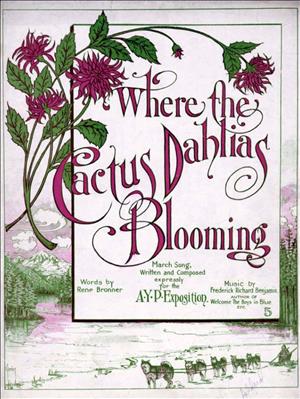On August 28, 1909, the Alaska-Yukon-Pacific (A-Y-P) Exposition blooms with color during Cactus Dahlia Day, commemorating the exposition's official flower. The exposition took place on the University of Washington campus in Seattle between June 1 and October 16, 1909. More than three million visitors came from around the state, the nation, and the world to view hundreds of exhibits, stroll the lushly manicured grounds, and be entertained on the midway, while Seattle promoted itself as a gateway to the rich resources of Alaska, the Yukon, and Asia. Each day (except Sundays) of the A-Y-P was designated as a Special Day for one or more groups. Special Days drew people involved in the featured organizations, and the resulting programs, lectures, ceremonies, parades, and athletic competitions gave local people a reason to visit again and again. On Cactus Dahlia Day the Washington State Building is decorated with thousands of cactus dahlias, in almost every conceivable color. Thousands more are planted throughout the fairgrounds. Organizers express the hope that the cactus dahlia will become to Seattle what the rose is to Portland: a source of civic pride and the anchor for an annual festival.
A committee headed by University of Washington Professor Edmond S. Meany (1862-1935) selected the cactus dahlia as the exposition’s official flower because of its adaptability to growing conditions in the Puget Sound region. With narrow petals in a starburst shape, cactus dahlias look a little like plump sea urchins. Meany recommended the species partly because of its long blooming season. Additionally, it was relatively new to Northwest gardeners, giving it the appeal of novelty.
"Where the Cactus Dahlia's Blooming"
The commemoration of Cactus Dahlia Day began in the early afternoon with a "flower parade" of girls and young women (50 in all, according to the Seattle Post-Intelligencer, 100 according to The Seattle Times). Led by the A-Y-P Band, the marchers walked two-by-two from the exposition’s main gate to the Washington State Building. They were dressed in white, garlanded with cactus dahlias, and carried bouquets in their hands. Inside the building, they massed themselves on the main staircase. A reporter for the P-I described the scene as "presenting the appearance of a huge flower bed."
The group then began singing "Where the Cactus Dahlia’s Blooming." The song, commissioned for the exposition, with words by Rene Bronner and music by Seattle composer Frederick Richard Benjamin, includes this chorus:
When the Cactus dahlia's blooming,
'Neath the sunny Western sky,
Where the lands are lovely booming
And the multitudes go by,
Then the dreams of old Seattle,
To the world will brightly shine
Where the Cactus dahlia's blooming
in the year of nineteen-nine.
Tables throughout the building held vases of dahlias offered for judging. More than 35 exhibitors put their best dahlias on display. Cactus dahlias were the stars of the show, but competitors also entered several other categories. Prizes were awarded in seven classes. Ruth and Dorothy Gleason, young daughters of Charles S. Gleason of Seattle, won three prizes: first and third in Class One, for a vase of three blooms of the same variety; and third in Class Two, for a vase of at least 12 blooms of different varieties. Mr. and Mrs. C. S. Davis, Seattle, also won three prizes, including second place in Class One and first in Class Two. The Sumner Commercial Club took first place in Class Seven, for the "best display of decorative dahlias, vases to contain not less than four blooms." The club’s entry contained dozens of cactus dahlias gathered by Sumner residents.
Dahlia History Lesson
The program also included a speech by Meany on the history of dahlias. He said the plant was native to Mexico, and figured as prominently in the ceremonies of the Aztecs as the fleur de lis and the rose in rituals in France and England, respectively. Among the first Westerners to identify the plant was Francisco Hernandez, physician to Phillip II of Spain, who traveled extensively in Mexico in the 1570s. Hernandez called it the star-shaped flower.
The plant was not grown in Europe until 1789, when seeds were sent from Mexico to Madrid. The English ambassador to Spain sent samples to the king’s garden in England. Meany said that English gardeners believed that dahlias (named after the Swedish botanist Andre Dahl) were greenhouse plants, since they were native to a semi-tropical region. They were grown only in under glass until the early nineteenth century. "From 1820 to 1860 the flower was much in favor in England, but after that time it was relegated to the backyards with the hollyhocks and sunflowers," said Meany.
The cactus dahlia was also discovered in Mexico, in 1872. The plant was little known in the Puget Sound region, outside of a few greenhouses and private gardens, and had the reputation of being too tender for the Northwest climate. Meany insisted that the cactus dahlia was perfectly suited to the Northwest. "I believe today’s exhibition has justified the selection of the flower to be the official exposition blossom," he said.
"Proclaim, ye heralds of the brilliant floral train," he added, in closing, "Proclaim this day the Cactus Dahlia’s reign" (The Seattle Times).
It proved to be a relatively short reign. The exposition’s promotion committee failed to convince the Seattle City Council to designate the cactus dahlia as the city’s official flower or to establish an annual Cactus Dahlia Festival. However, the Washington Equal Suffrage Association did give the cactus dahlia a bit of a boost. The Washington Women's Cook Book, published by the association in 1909, specified that the table be decorated with cactus dahlias for a "Washington State Dinner."

